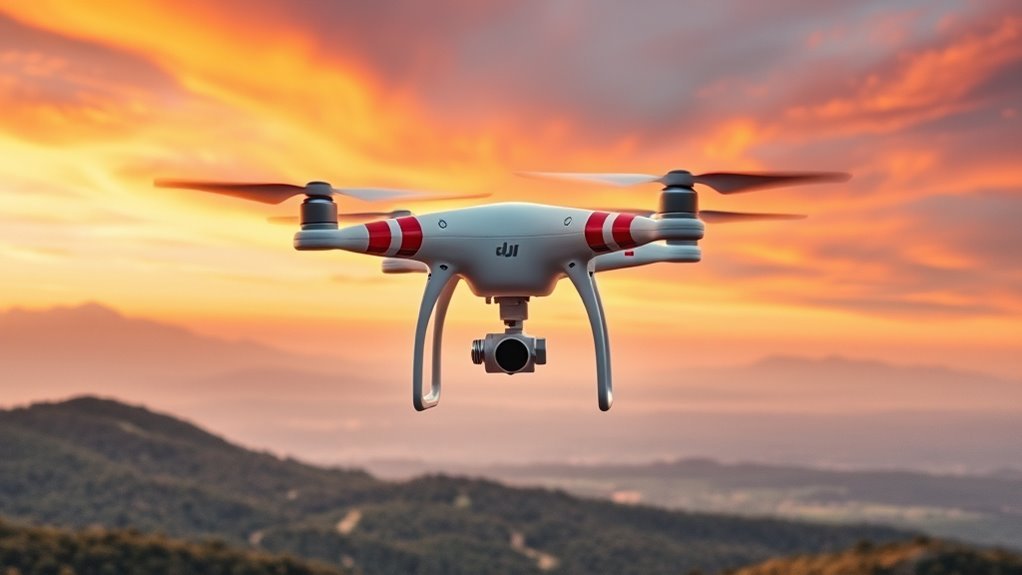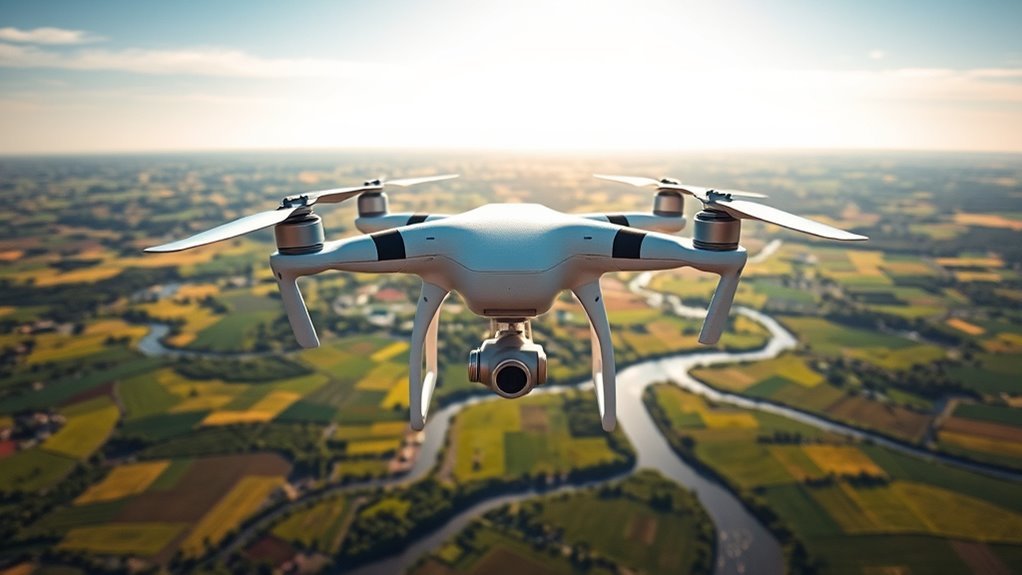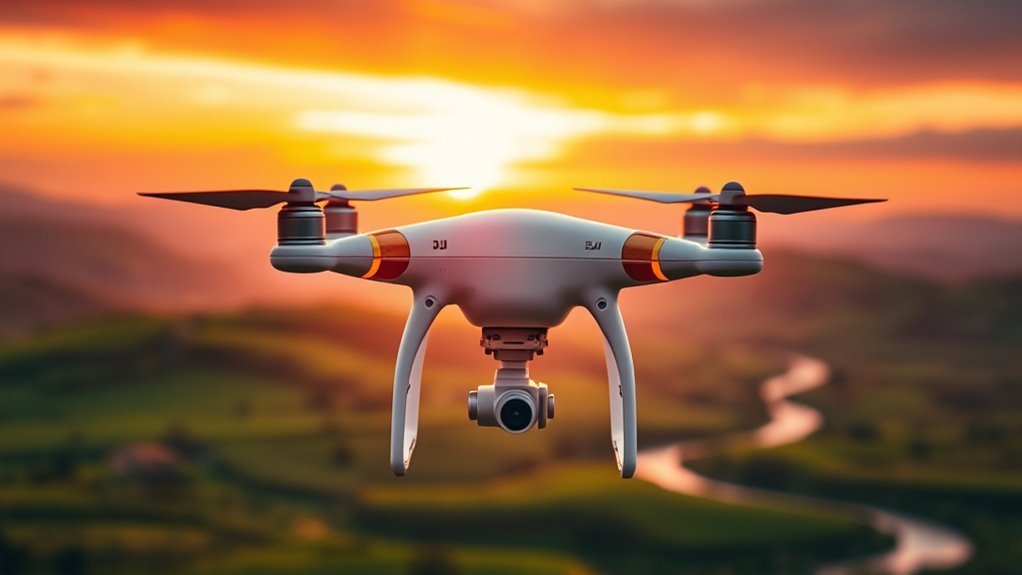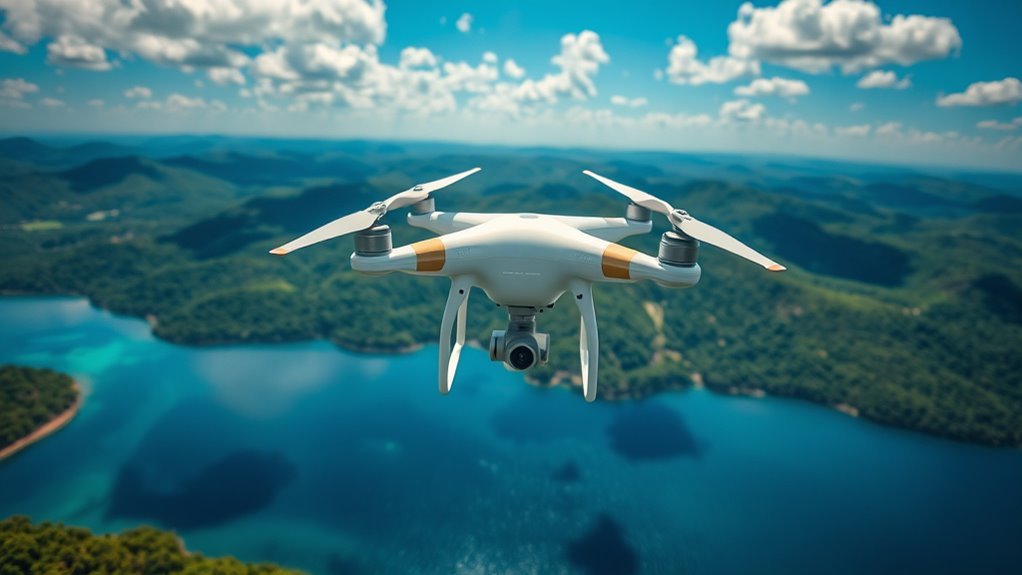If you’re considering the DJI Phantom 3 Advanced, you’ll appreciate its solid build with ergonomic comfort and durable materials. It boasts a sharp 12MP camera capturing vibrant 2.7K video, supported by stable GPS flight and intelligent modes like Follow Me. The controllability via remote and app is intuitive, though battery life limits lengthy sessions. While it lacks advanced collision sensors, its balance of features suits hobbyists well. Explore further to understand all its capabilities and trade-offs.
Design and Build Quality

The DJI Phantom 3 Advanced’s design reflects a balance between durability and functionality, tailored to meet the needs of both hobbyists and professional users. You’ll appreciate its ergonomic design, which guarantees comfortable handling and easy control during extended flights. The thoughtfully contoured body reduces fatigue, allowing you to focus on capturing your desired shots without distraction. The drone’s build materials combine lightweight plastic with reinforced components, providing resilience against minor impacts while preserving portability. This careful selection enhances overall structural integrity without adding unnecessary weight, granting you greater freedom to explore diverse environments. The modular construction also facilitates straightforward maintenance and part replacement, extending the drone’s lifespan. Overall, the design and build quality support a user experience centered on reliability and effortless maneuverability, essential for those seeking unrestricted aerial exploration.
Camera Specifications and Image Quality

Equipped with a 12-megapixel camera, the DJI Phantom 3 Advanced delivers impressive image clarity suitable for both casual photography and professional applications. You’ll appreciate the lens performance, which offers sharpness across the frame and minimal distortion, allowing for crisp aerial shots. The camera’s sensor excels in capturing fine detail, even in varied lighting conditions. Color accuracy is another strong point, with natural, balanced tones that require little post-processing to achieve true-to-life visuals. The drone supports 2.7K video recording, providing smooth footage with rich detail, enhancing your creative freedom. Overall, the Phantom 3 Advanced’s camera setup strikes a balance between technical capability and ease of use, making it a versatile tool whether you’re exploring new perspectives or capturing high-quality content.
Flight Performance and Stability

You’ll notice the Phantom 3 Advanced offers impressive hovering accuracy, maintaining position with minimal drift even in challenging conditions. Its wind resistance capabilities are equally notable, allowing for stable flight in moderate breezes without compromising control. These factors play a critical role in ensuring consistent performance during both casual and professional use.
Hovering Accuracy
Precision is essential when it comes to hovering, and the DJI Phantom 3 Advanced demonstrates impressive stability in this area. Thanks to its integrated GPS technology, the drone maintains a fixed position with minimal drift, allowing you to focus on capturing steady footage without constant manual adjustments. Its sensor accuracy further enhances this stability by providing real-time data on altitude and orientation, ensuring the drone remains locked in place even during subtle environmental changes. This combination of technologies grants you the freedom to execute complex shots confidently, knowing the drone will hold its position reliably. While hovering, you’ll notice the Phantom 3 Advanced responds smoothly to control inputs, reflecting the seamless integration between hardware and software designed to maximize flight precision and user control.
Wind Resistance
Although wind can pose significant challenges to drone stability, the DJI Phantom 3 Advanced handles moderate gusts with notable resilience. Thanks to its refined drone aerodynamics, this model maintains steady flight even when weather conditions are less than ideal. You’ll notice the drone’s frame and propeller design help minimize drag and counteract turbulence, allowing for smoother control. However, in stronger winds, you might experience slight deviations that require manual adjustment. Understanding these limitations guarantees you can plan flights that maximize stability while embracing freedom in the air. Overall, the Phantom 3 Advanced strikes a balance between responsiveness and steadiness, making it a reliable choice for flights in variable weather conditions without sacrificing performance or your control experience.
Battery Life and Charging
Battery performance is a critical factor in drone operation, and the DJI Phantom 3 Advanced offers a flight time of approximately 23 minutes on a fully charged battery. This duration balances well between weight and battery efficiency, allowing you to explore without frequent interruptions. The intelligent flight battery optimizes power consumption, enhancing overall efficiency while maintaining consistent performance during flight. Charging time is another important consideration; the standard charger replenishes the battery in roughly 90 minutes, which is reasonable for most users seeking quick turnaround. While 23 minutes may limit extended excursions, carrying spare batteries can extend your freedom to fly longer sessions. Overall, the Phantom 3 Advanced’s battery life and charging setup provide a practical compromise, enabling you to enjoy reliable flight times without excessive downtime.
Control Options and User Interface
When flying the DJI Phantom 3 Advanced, you’ll rely on a remote controller that offers precise input and ergonomic design, enhancing your handling experience. The integration with DJI’s mobile app provides real-time telemetry and intuitive touchscreen controls, making adjustments straightforward. Additionally, accessible flight modes allow you to tailor the drone’s behavior to your skill level and shooting needs efficiently.
Remote Controller Features
The remote controller of the DJI Phantom 3 Advanced offers a well-balanced combination of control options and an intuitive user interface designed to enhance your flying experience. Its remote control functionality is precise, allowing you to maneuver the drone smoothly and responsively. Controller ergonomics are thoughtfully engineered, with comfortable grips and well-placed buttons that minimize fatigue during extended flights. You’ll appreciate how the layout supports quick adjustments without losing focus. Key features include:
- Dedicated buttons for camera control and flight modes
- Responsive joysticks with adjustable sensitivity
- LCD status screen displaying battery life and signal strength
- Foldable design for portability
- Anti-slip surface enhancing grip stability
This controller design guarantees you maintain freedom and confidence while piloting, emphasizing control accuracy and user comfort.
Mobile App Integration
Although the DJI Phantom 3 Advanced’s remote controller offers robust physical controls, integrating its mobile app greatly expands your command and customization options. The app functionality complements the controller by providing live HD video streaming, intuitive camera settings, and real-time telemetry data. You can adjust exposure, white balance, and flight parameters on the fly, enhancing your user experience through precise control and immediate feedback. The interface is logically structured, minimizing distractions and allowing you to focus on flight freedom. Additionally, the app facilitates firmware updates and intelligent flight planning, streamlining maintenance and navigation tasks. By combining physical controls with this app, you gain a flexible and extensive system that adapts to your flying style, ensuring you maintain full control without sacrificing ease of use or responsiveness.
Flight Mode Accessibility
Even if you’re new to drone piloting, you’ll find the DJI Phantom 3 Advanced offers straightforward access to multiple flight modes through both its remote controller and mobile app interface. The system is designed to simplify flight mode switching, giving you the freedom to adapt quickly to different flying conditions. The remote’s dedicated mode switch lets you toggle between essential flight mode types, while the app provides a visual, intuitive interface to customize and select modes with precision. This dual accessibility guarantees you maintain control whether you prefer physical switches or touchscreen commands. Key flight mode types include:
- P-mode (Positioning) for GPS-assisted stable flight
- S-mode (Sport) for faster, more agile movement
- A-mode (Attitude) for manual control without GPS
- Waypoint mode for pre-planned flight paths
- Follow Me mode for autonomous tracking
Together, these options empower you to explore with confidence.
Safety Features and Flight Modes
When you pilot the DJI Phantom 3 Advanced, its safety features and flight modes work seamlessly to enhance control and reduce risks. The drone includes intelligent flight modes like Follow Me and Waypoints, giving you freedom to focus on capturing footage while it maneuvers precisely. Although it lacks advanced collision avoidance sensors found in newer models, it compensates with GPS-based positioning and vision sensors that help maintain stable flight and prevent crashes. Should signal loss or low battery occur, the automatic Return-to-Home and emergency landing functions activate, guiding the drone safely back or to a controlled descent. These integrated systems provide a balanced blend of autonomy and manual control, empowering you to explore confidently without sacrificing safety during your flights.
Pros and Cons of the DJI Phantom 3 Advanced
The DJI Phantom 3 Advanced offers a compelling mix of features that cater to both amateur and experienced drone pilots. When considering user experience and feature comparison, it stands out for its intuitive controls and reliable GPS, but also shows some limitations in battery life and weight.
- Precise GPS positioning enhances flight stability and navigation freedom
- 2.7K camera quality supports impressive aerial photography
- Intelligent flight modes simplify complex maneuvers for beginners
- Relatively short flight time restricts extended sessions
- Heavier frame impacts portability compared to newer models

